|
Concordia
Author: Mac Gerdts
Publisher: PD Verlag/Heidelberger Spieleverlag
Year: 2013
review by

| x |
|
|
|
|
|
|
|
|
|
|
|
|
|
|
|
|
|
|
|
|
|
|
|
|
|
|
|
|
|
|
|
|
|
|
|
|
|
|
|
|
|
|
|
|
|
|
|
|
|
|
|
|
|
|
|
|
|
|
|
|
|
|
|
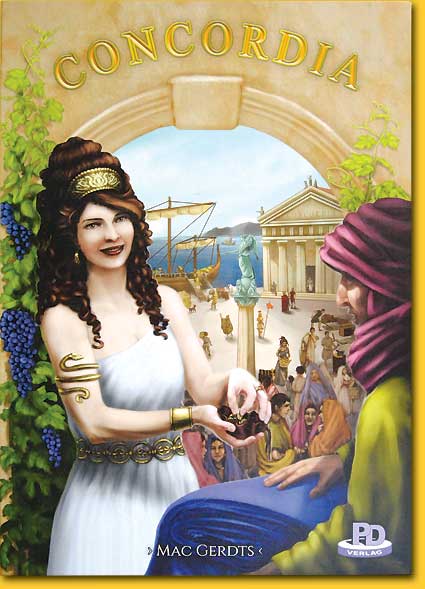 |
Two to five players find themselves in an as usual familiar environment: depending on the number of players they play on a map of the Mediteranean or on a map of Italy. They are storekeeper of a number of goods that they can trade, and they send out their settlers over land and sea to develop new areas. With a handfull of character cards they direct their actions, and from a display they recruit new characters that must be paid with with a varying amount and type of goods. Besides, each character card is dedicated to a god who will reward the owning player in different ways with victory points. When the display of cards is empty and all characters have been bought, or when a player has built his fifteenth colony, the game ends when the last round is completed. |
|
|
|
|
|
|
|
|
| x |
|
|
|
|
|
|
|
|
|
|
|
|
|
|
|
|
|
|
|
|
|
|
|
|
|
|
|
|
|
|
|
|
|
|
|
|
|
|
|
|
|
|
|
|
|
|
|
|
|
|
|
|
|
|
|
|
|
|
|
|
|
|
|
| Each of the thirty cities on the map of the Mediterranean more or less randomly gets a tile; it depicts what the city produces. By province -there are twelve of them; eleven on the map of Italy- is determined what the highest value product is, with brick having the lowest and cloth the highest value; each province this way is marked with a bonus marker. All players start with some money and goods and two settlers in Rome, one on foot, the other by ship. They also each have an identic starter set of seven character cards, of which they each turn play one and perform the action that goes with it. |
|
|
|
|
|
|
|
|
|
|
|
|
|
|
| x |
|
|
|
|
|
|
|
|
|
|
|
|
|
|
|
|
|
|
|
|
|
|
|
|
|
|
|
|
|
|
|
|
|
|
|
|
|
|
|
|
|
|
|
|
|
|
|
|
|
|
|
|
|
|
|
|
|
|
|
|
|
|
|
|
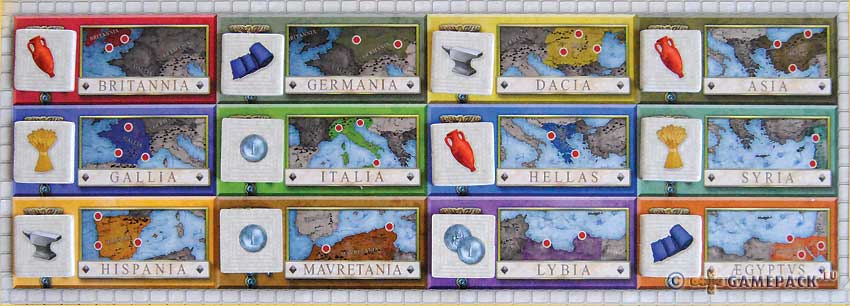
|
|
|
|
|
|
|
| xx |
|
|
|
|
|
|
|
|
|
|
|
|
|
|
|
|
|
|
|
|
|
|
|
|
|
|
|
|
|
|
|
|
|
|
|
|
|
|
|
|
|
|
|
|
|
|
|
|
|
|
|
|
|
|
|
|
|
|
|
|
|
|
|
| Usually in the first turn the architect will be played, where the settlers may be moved along routes as many as a player has settlers on the board -at start two, the movement free to divide among one or more settlers- after which adjacent cities against payment may be colonised and a house in the player colour may be placed. This usually costs one food plus the good that is produced in the city, and money: dependant on the type of good from 1 to 5 money. When other players already colonised this city, the costs in money are multiplied by the already present players. Especially during the first stage of the game players will avoid these additional costs and seek free space in cities where no other players have built. |
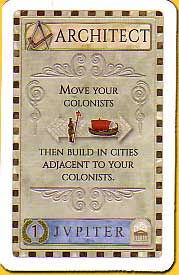 |
|
|
|
|
|
|
| x |
|
|
|
|
|
|
|
|
|
|
|
|
|
|
|
|
|
|
|
|
|
|
|
|
|
|
|
|
|
|
|
|
|
|
|
|
|
|
|
|
|
|
|
|
|
|
|
|
|
|
|
|
|
|
|
|
|
|
|
|
|
|
|
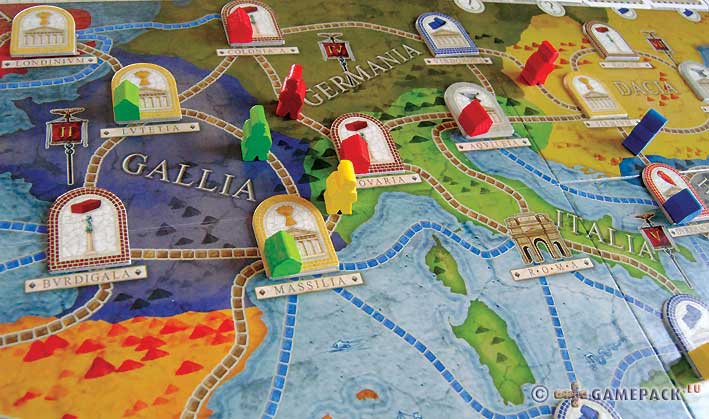 |
|
|
|
|
|
| x |
|
|
|
|
|
|
|
|
|
|
|
|
|
|
|
|
|
|
|
|
|
|
|
|
|
|
|
|
|
|
|
|
|
|
|
|
|
|
|
|
|
|
|
|
|
|
|
|
|
|
|
|
|
|
|
|
|
|
|
|
|
|
|
| To get to the necessary goods, the Mercator can be played with which two type of goods can be traded: buy or sell two of a different kind, or buy one of one kind and sell one of another. There are fixed prices at the market, for instance brick costs/provides 3 money, and cloth 7. |
|
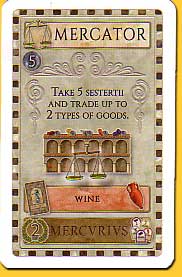 |
|
|
|
|
|
| x |
|
|
|
|
|
|
|
|
|
|
|
|
|
|
|
|
|
|
|
|
|
|
|
|
|
|
|
|
|
|
|
|
|
|
|
|
|
|
|
|
|
|
|
|
|
|
|
|
|
|
|
|
|
|
|
|
|
|
|
|
|
|
|
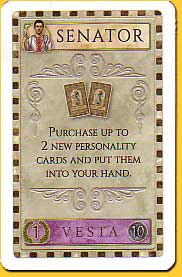 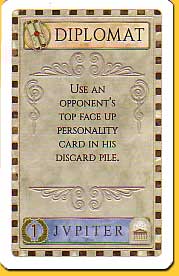 |
|
With other character cards new cards can be bought from the display, or the card copies the card an other player has played. The card that takes all played cards back into a players hand also is not unimportant, although this always feels as a lost turn. But at least the player again has the architect to his disposal with which he can continue to move his settlers on the board. This action also provides some extra money, and in addition the player may place a new settler on the board for one food and one tool. |
|
|
|
|
|
|
| x |
|
|
|
|
|
|
|
|
|
|
|
|
|
|
|
|
|
|
|
|
|
|
|
|
|
|
|
|
|
|
|
|
|
|
|
|
|
|
|
|
|
|
|
|
|
|
|
|
|
|
|
|
|
|
|
|
|
|
|
|
|
|
|
| With the prefect a player may choose from two actions: either he decides the province will produce, earning the goods from all houses in that province -so including houses from other players- or he chooses to take all the money that is depicted on previously used province bonus markers. When choosing the first action, the player may take the goods depicted from cities he has houses in, plus the good depicted on the province bonus marker. The bonus marker then is flipped upside down and now depicts one or two money. As already mentioned, because this is a province-wide action, all other players with houses in that province also may take the goods from their citieshis action usually is taken in a province where the active player has more houses than other players; he doesn't want to benefit them more than necessary. To keep an eye on the stock in the warehouses of other players can not hurt either: space is limited, and when the warehouse is full no more goods can be taken. |
|
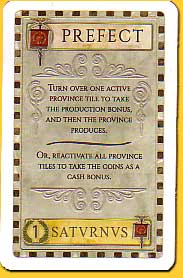 |
|
|
|
|
|
| x |
|
|
|
|
|
|
|
|
|
|
|
|
|
|
|
|
|
|
|
|
|
|
|
|
|
|
|
|
|
|
|
|
|
|
|
|
|
|
|
|
|
|
|
|
|
|
|
|
|
|
|
|
|
|
|
|
|
|
|
|
|
|
|
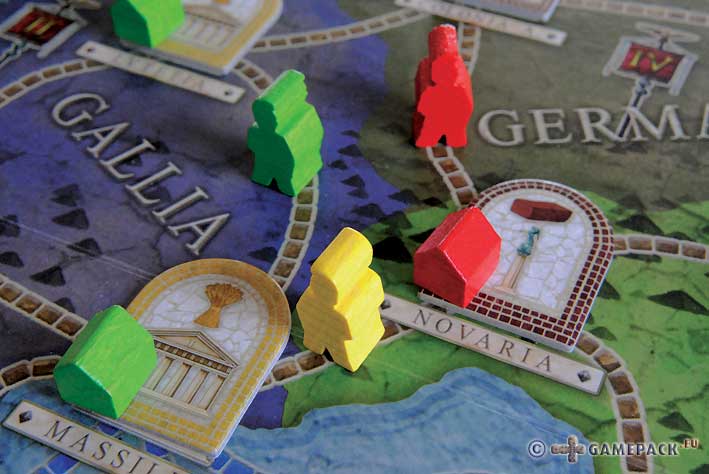 |
|
|
|
|
| x |
|
|
|
|
|
|
|
|
|
|
|
|
|
|
|
|
|
|
|
|
|
|
|
|
|
|
|
|
|
|
|
|
|
|
|
|
|
|
|
|
|
|
|
|
|
|
|
|
|
|
|
|
|
|
|
|
|
|
|
|
|
|
|
| This decribes the mechanism of colonization, production and generate income, but ultimately it all is about the points that lead to victory, and these are controlled by the character cards. With the senator up to two character cards can be bought; on each card is depicted what it costs, from brick to cloth, plus the good or goods that are determined by the position in the display. These newly recruited characters with often better qualifications than those from the starter set are taken in the player's hand and can be played from a next turn. |
|
|
|
|
|
|
| x |
|
|
|
|
|
|
|
|
|
|
|
|
|
|
|
|
|
|
|
|
|
|
|
|
|
|
|
|
|
|
|
|
|
|
|
|
|
|
|
|
|
|
|
|
|
|
|
|
|
|
|
|
|
|
|
|
|
|
|
|
|
|
|
 |
|
|
| x |
|
|
|
|
|
|
|
|
|
|
|
|
|
|
|
|
|
|
|
|
|
|
|
|
|
|
|
|
|
|
|
|
|
|
|
|
|
|
|
|
|
|
|
|
|
|
|
|
|
|
|
|
|
|
|
|
|
|
|
|
|
|
|
| At the bottom of each character card is staed what it scores at game end: 1 point for each province a player has at least one house in, 2 points per settler, or 2 points per set of five different produced goods. And then there are the character cards that score points for each producing city of a specific good, such as 5 points for each cloth producing city where a player has built a house, or 3 points for each city where tool is produced. For clarity: the points score per character card, so when a player has collected several cards of a kind, he will score proportionally! |
|
|
|
|
|
|
| x |
|
|
|
|
|
|
|
|
|
|
|
|
|
|
|
|
|
|
|
|
|
|
|
|
|
|
|
|
|
|
|
|
|
|
|
|
|
|
|
|
|
|
|
|
|
|
|
|
|
|
|
|
|
|
|
|
|
|
|
|
|
|
|
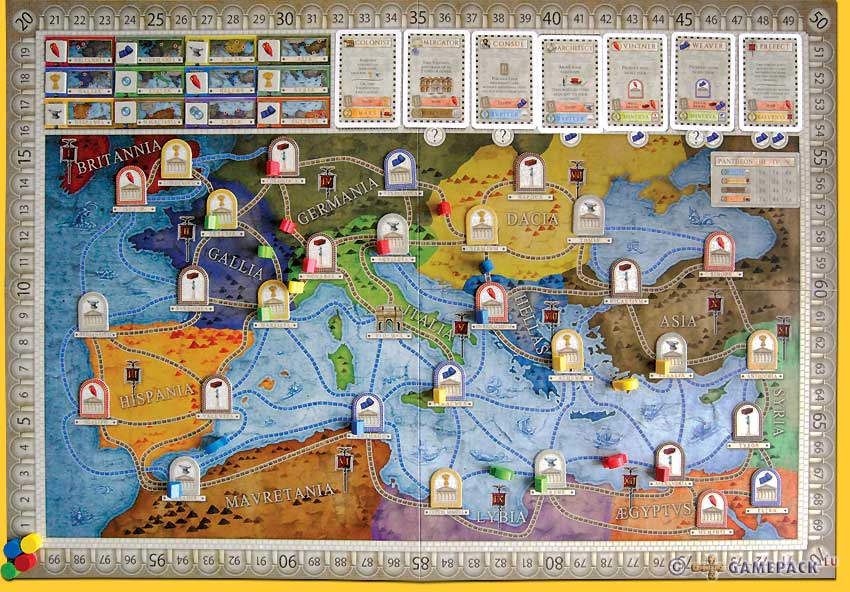 |
|
|
| x |
|
|
|
|
| x |
|
|
|
|
| x |
|
|
|
|
 |
|
|
|
|
|
|
|
|
|
|
|
|
|
|
|
|
|
|
|
|
|
|
|
|
|
|
|
|
|
|
|
|
|
|
|
|
|
|
|
|
|
|
|
|
|
|
|
|
|
|
|
|
|
|
| Just one little cardboard explaining the set up and only four pages of rules; it is this little needed to play the game. The game plays very fast and intuitive: play a card, perform the action of it, and it's on to the next player! It's merely considerations such as whìch card to play, and whère the settler should move to or which goods have to be traded with which a player is concerned with; but usually he already made the necessary decisions outside his turn so it stays a fluid game. |
|
|
|
|
|
|
| x |
|
|
|
|
|
|
|
|
|
|
|
|
|
|
|
|
|
|
|
|
|
|
|
|
|
|
|
|
|
|
|
|
|
|
|
|
|
|
|
|
|
|
|
|
|
|
|
|
|
|
|
|
|
|
|
|
|
|
|
|
|
|
|
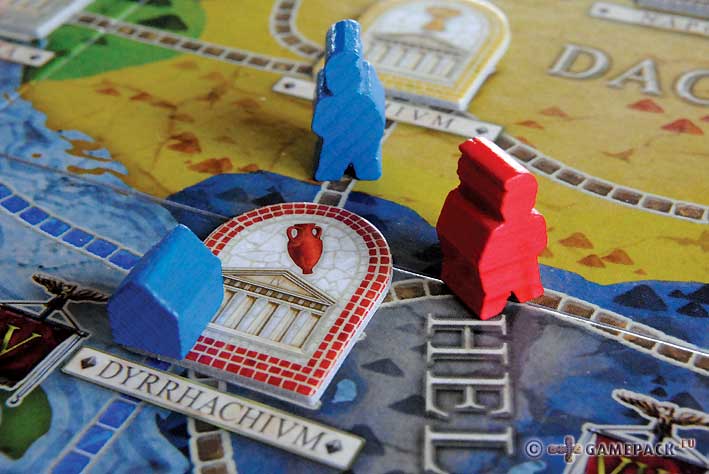 |
|
|
|
|
|
|
| x |
|
|
|
|
|
|
|
|
|
|
|
|
|
|
|
|
|
|
|
|
|
|
|
|
|
|
|
|
|
|
|
|
|
|
|
|
|
|
|
|
|
|
|
|
|
|
|
|
|
|
|
|
|
|
|
|
|
|
|
|
|
|
|
Having more settlers also means to be able to move more and further. This way provinces and cities can be reached that have not yet been colonised by other players, which saves the additional costs. Brick anbd food maybe at the bottom of the financial ladder, but brick is a basis in almost every city to build a house, and food, together with tools supplies an extra settler.
Settlers are not allowed to be on the same route, so some planning is required in movement. To efficiently build houses it is convenient to reach a route with two empty cities on both sides. To be able to pay the costs of housing the player must have the necessary goods in his warehouse, though. |
|
|
|
|
|
|
| x |
|
|
|
|
|
|
|
|
|
|
|
|
|
|
|
|
|
|
|
|
|
|
|
|
|
|
|
|
|
|
|
|
|
|
|
|
|
|
|
|
|
|
|
|
|
|
|
|
|
|
|
|
|
|
|
|
|
|
|
|
|
|
|
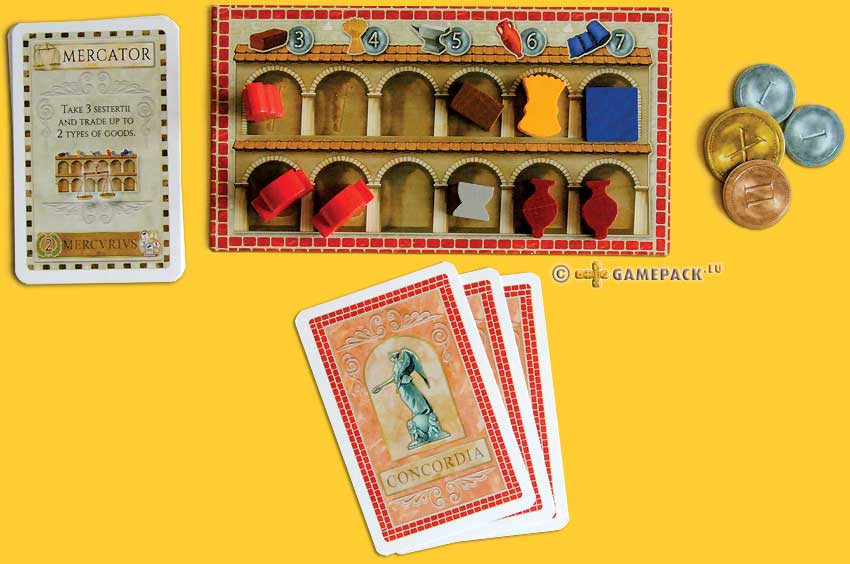 |
|
|
Because it is clear which character cards are on display at any given moment and what they score, it may seem that a player will adjust his tactics accordingly. But rather he will try to colonise as much cities as possible during the first stage of the game, without having to pay additional costs, as well as trying to have a varied production of goods.
When an attractive character card presents itself against low costs, it always pays to buy it; it often turns out that the player with lots of character cards has a greater chance of winning, so it's not a specific kind of character card that does it. So first comes the purchase and spreading of houses on the board, whereever, andafter that the focus for victory points and fine tuning. But this often comes very late, towards the end of the game. When all players make a run on the character cards, there is very little left of the depth intended by the author. |
|
|
|
|
|
|
| x |
|
|
|
|
|
|
|
|
|
|
|
|
|
|
|
|
|
|
|
|
|
|
|
|
|
|
|
|
|
|
|
|
|
|
|
|
|
|
|
|
|
|
|
|
|
|
|
|
|
|
|
|
|
|
|
|
|
|
|
|
|
|
|
 |
|
|
|
|
|
|
| x |
|
|
|
|
|
|
|
|
|
|
|
|
|
|
|
|
|
|
|
|
|
|
|
|
|
|
|
|
|
|
|
|
|
|
|
|
|
|
|
|
|
|
|
|
|
|
|
|
|
|
|
|
|
|
|
|
|
|
|
|
|
|
|
This makes it less of a tactical game than one would initially think it would be. A player simply has to grasp his opportunities, and even occasionally take a gamble. Cloth is valuable and earns 7 money when sold, but the more expensive cards in the display must be paid too with this commodity. Sell or keep?
Furthermore, a province in which a player has a house in a cloth producing city will be more subject to be chosen for production by other players who do not have a house there, resulting in receiving a valuable cloth outside the player's turn. |
|
|
|
|
|
|
| x |
|
|
|
|
|
|
|
|
|
|
|
|
|
|
|
|
|
|
|
|
|
|
|
|
|
|
|
|
|
|
|
|
|
|
|
|
|
|
|
|
|
|
|
|
|
|
|
|
|
|
|
|
|
|
|
|
|
|
|
|
|
|
|
 |
|
|
|
|
|
|
| x |
|
|
|
|
|
|
|
|
|
|
|
|
|
|
|
|
|
|
|
|
|
|
|
|
|
|
|
|
|
|
|
|
|
|
|
|
|
|
|
|
|
|
|
|
|
|
|
|
|
|
|
|
|
|
|
|
|
|
|
|
|
|
|
| A downside is that a five player game takes way too long because of increasing waitng times, whereas in a two player game there is just too much space on the (Italian) board, resulting in less tension; the ideal number of players clearly lies at three or four. |
|
|
|
|
|
|
| x |
|
|
|
|
|
|
|
|
|
|
|
|
|
|
|
|
|
|
|
|
|
|
|
|
|
|
|
|
|
|
|
|
|
|
|
|
|
|
|
|
|
|
|
|
|
|
|
|
|
|
|
|
|
|
|
|
|
|
|
|
|
|
|
 |
Finally, there is the flying keeper: the Praefectus Magnus. At the start of the game this card goes to the last player and travels counterclockwise to the next player any time the possesing player uses the Praefect for production. The player may double the province bonus; a nice sweetener, but fairly useless because in fact all players equally profit from it, so there is no benefit other than breaking a possible tie at game end. |
|
|
|
|
|
|
| x |
|
|
|
|
|
|
|
|
|
|
|
|
|
|
|
|
|
|
|
|
|
|
|
|
|
|
|
|
|
|
|
|
|
|
|
|
|
|
|
|
|
|
|
|
|
|
|
|
|
|
|
|
|
|
|
|
|
|
|
|
|
|
|
Concordia is quickly explained and quickly understood. Players grasp the game from the very first start; the seasoned player has no distinct advantage here. Concordia: it is transparent, light, fast -except with five-, with plenty of interesting choices without getting hard, and it appeals to everyone.
A somewhat advanced family game, partly because of the theme disguised as Kennerspiel, who would have thought this?
© 2014 Richard van Vugt
Concordia, Mac Gerdts, Heidelberger Spieleverlag/PD Verlag, 2013 - 2 to 5 players, 12 years and up, 90 minutes
|
|
|
|
|
  |
|
|
|
|
|
|
|
|
|
|
|
|
|
|
|
|
|
|
|
|
|
|
|
|
|
|
|
|
|
|
|
|
|
|
|
|
|
|
|
|
|
|
|
|
|
|
|
|
|
|
|
|
|
|
  |
|
|
|
|
|
|
|
|
|
|
|
|
|
|
|
|
|
|
|
|
|
|
|
|
|
|
|
|
|
|
|
|
|
|
|
|
|
|
|
|
|
|
|
|
|
|
|
|
|
|
|
|
|
|
  |
|
|
|
|
|
|
|
|
|
|
|
|
|
|
|
|
|
|
|
|
|
|
|
|
|
|
|
|
|
|
|
|
|
|
|
|
|
|
|
|
|
|
|
|
|
|
|
|
|
|
|
|
|
|
  |
|
|
|
|
|
|
|
|
|
|
|
|
|
|
|
|
|
|
|
|
|
|
|
|
|
|
|
|
|
|
|
|
|
|
|
|
|
|
|
|
|
|
|
|
|
|
|
|
|
|
|
|
|
|
| x |
|
|
|
|
|
|
|
|
|
|
|
|
|
|
|
|
|
|
|
|
|
|
|
|
|
|
|
|
|
|
|
|
|
|
|
|
|
|
|
|
|
|
|
|
|
|
|
|
|
|
|
|
|
|
|
|
|
|
|
|
|
|
|
| x |
|
|
|
|
|
|
|
|
|
|
|
|
|
|
|
|
|
|
|
|
|
|
|
|
|
|
|
|
|
|
|
|
|
|
|
|
|
|
|
|
|
|
|
|
|
|
|
|
|
|
|
|
|
|
|
|
|
|
|
|
|
|
|
 |
|
|
|
|
|
|
|
|
|
|
|
|
|
|
|
|
|
|
|
|
|
|
|
|
|
|
|
|
|
|
|
|
|
|
|
|
|
|
|
|
|
|
|
|
|
|
|
|
|
|
|
|
|
|
 |
|
|
|
|
|
|
|
|
|
|
|
|
|
|
|
|
|
|
|
|
|
|
|
|
|
|
|
|
|
|
|
|
|
|
|
|
|
|
|
|
|
|
|
|
|
|
|
|
|
|
|
|
|
|
| x |
|
|
|
|
|
|
|
|
|
|
|
|
|
|
|
|
|
|
|
|
|
|
|
|
|
|
|
|
|
|
|
|
|
|
|
|
|
|
|
|
|
|
|
|
|
|
|
|
|
|
|
|
|
|
|
|
|
|
|
|
|
|
|
 |
|
|
|
|
|
|
|
|
|
|
|
|
|
|
|
|
|
|
|
|
|
|
|
|
|
|
|
|
|
|
|
|
|
|
|
|
|
|
|
|
|
|
|
|
 |
|
|
|
|
|
|
|
|
|
|
|
|
|
|
|
|
|
|
|
|
|
|
|
|
|
|
|
|
|
|
|
|
|
|
|
|
|
|
|
|
|
|
|
|
|
|